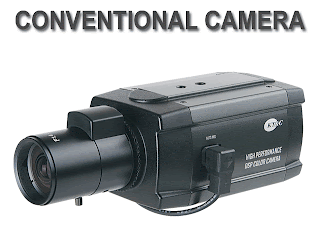DIGITAL CAMERA
An increasingly popular of use of computers is for digital photography, making digital cameras a kind of computer peripheral. Let us briefly see how that works.
COMPONENT OF CAMERA
All camera have a lens that forms an image of the subject in the back of the camera.
CONVENTIONAL CAMERA
In the back of camera is lined with film, on which a latent image is formed when light strikes it. The latent image can be made visible by the actions of certain chemicals in the film developer.
DIGITAL CAMERA
Works same way with conventional camera except that the film is replaced by a rectangular array of CCDs (Charge-Couple Devices) that are sensitive to light. (some digital camera use CMOS, but we will concentrate on the more common CCDs here)
When lights strikes CCD, it requires an electrical charge. The more light, the more charge. The charge can be read off by an analog-to-digital converter as an integer from 0 to 225 (on low-end camera) or from 0 to 4095 (on digital single-lens-reflex cameras).
Each CCD produces a single value, independent of the color of light striking it. To form color image, the CCDs are organized in group of four elements. A Bayer filter (click to know more) is placed on top of the CDDs to allow only red light to strike one of the four CCDs in each group , blue light to strike another one, and green light to strike the other two.
 |
| Process in camera |
 |
| Bayer filter array |
- Setting the focus
- Determining the exposures
- Performing the white balance
CAMERA SOFTWARE
- AUTOFOCUS works by :
 |
| Auto Focus |
- analyzing the high-frequency information in the image and then moving the lens until its maximized
2. EXPOSURE determine by ;
 |
| Exposure |
- measuring the light falling on the CCD's
- adjusting the lens diaphragm
- exposure time to have the light intensity fall in the middle of the CCd's range
 |
| White Balance |
- measuring the spectrum of the incident light to perform necessary color correction in the post processing
- image is read off the CCD and stored as a pixel array in the cameras internal RAM.
PHASE DIGITAL CAMERA PRODUCE IMAGE
- Post-Capture Phase
2. Applies an algorithm to do noise reduction and another one to compensate for defective CCD's.
- camera's software applies the white balance color correction to compensate for reddish or bluish light (e.g from a subject in shadow or the used of flash.
3. Attempts to sharpen image (unless this features has been disables) by looking for edge and increasing the intensity gradient around them.
PRODUCING AN IMAGE
Image is compressed to reduce the amount of storage required.
The format of image usually is JPEG (Joint Photographic Expert Group) which a 2D spatial Fourier transform applied and some of the high-frequency component omitted.
The result of transformation is the image requires fewer bits to store but fine detail is lost.
STORAGE MEDIUM
- Flash Memory
- SD Card
- Thumb drive
- External hard disk
- Micro drive
- crop the image
- adjust brightness
- contrast
- color balance
- sharpen
- blur
- remove portions of the image
- apply numerous filter
enjoy this video :)
"Technology is just a tool. In terms of getting the kids working together and motivating them, the teacher is the most important."
Bill Gates
posted by
Aqeelah Napis
(B031310448)


No comments:
Post a Comment